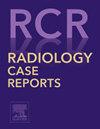Nonseminomatous mixed germ cell tumor of the testis: Case report
Q4 Medicine
引用次数: 0
Abstract
Testicular germ cell tumors (GCTs) are the most common solid malignancies in young males, with nonseminomatous germ cell tumors (NSGCTs) representing a significant subset characterized by aggressive behavior and elevated tumor markers. This case report highlights the diagnostic and therapeutic challenges in a young male with a history of surgically corrected testicular ectopy, presenting with progressive testicular enlargement and pain, ultimately diagnosed as a mixed NSGCT. A 25-year-old male presented with a 1-month history of right testicular enlargement and pain. Physical examination revealed a tender, enlarged right testicle. Laboratory investigations showed elevated tumor markers, including Alpha-fetoprotein (AFP: 1,200 ng/mL) and Beta-human chorionic gonadotropin (BHCG: 450 IU/L). Magnetic Resonance Imaging (MRI) of the scrotum was performed, including T2-weighted axial and coronal sequences, diffusion-weighted imaging (DWI), and dynamic contrast-enhanced imaging (DCE-MRI) with gadolinium. Radical inguinal orchiectomy was performed, and the resected specimen was subjected to histopathological examination. MRI revealed a large, heterogeneously hyperintense mass (50 × 50 × 45 mm) replacing the right testicular parenchyma, with irregular margins, hemorrhagic streaks, and low apparent diffusion coefficient (ADC) values (0.6 × 10⁻⁶ mm²/s). Dynamic postcontrast imaging demonstrated weak and progressive enhancement, consistent with NSGCT. Radical orchiectomy confirmed a grossly enlarged testicle with necrotic and hemorrhagic regions. Histopathology confirmed a mixed NSGCT, comprising embryonal carcinoma and yolk sac tumor components. Postoperative recovery was uneventful, and the patient was referred for further oncological management. This case underscores the importance of a multimodal diagnostic approach, integrating clinical evaluation, tumor markers, advanced imaging, and histopathology, in the management of testicular malignancies. Elevated AFP and BHCG levels were pivotal in raising suspicion for NSGCT, while MRI provided detailed characterization of the tumor’s size, internal architecture, and enhancement patterns, guiding surgical intervention. The histopathological findings confirmed the aggressive nature of the tumor, necessitating a multidisciplinary approach for further management. Early diagnosis and prompt intervention are critical for improving outcomes in patients with NSGCTs, particularly those with mixed histological components. This case highlights the pivotal role of MRI in diagnosing and staging testicular malignancies, complemented by tumor markers and histopathology. The integration of these modalities ensures accurate diagnosis and guides appropriate surgical and oncological management. Future studies should focus on refining imaging techniques and biomarkers to enhance diagnostic precision and personalize treatment strategies for testicular GCTs.
睾丸非半精瘤性混合生殖细胞瘤1例
睾丸生殖细胞肿瘤(gct)是年轻男性中最常见的实体恶性肿瘤,非半精瘤性生殖细胞肿瘤(nsgct)是一个重要的亚群,其特征是侵袭性行为和肿瘤标志物升高。本病例报告强调了诊断和治疗的挑战,在一个年轻的男性手术纠正睾丸切除的历史,表现为进行性睾丸增大和疼痛,最终诊断为混合性NSGCT。25岁男性,右睾丸肿大及疼痛1个月。体格检查发现右睾丸触痛肿大。实验室检查显示肿瘤标志物升高,包括甲胎蛋白(AFP: 1200 ng/mL)和β -人绒毛膜促性腺激素(BHCG: 450 IU/L)。对阴囊进行磁共振成像(MRI),包括t2加权轴位和冠状位序列、扩散加权成像(DWI)和钆动态对比增强成像(DCE-MRI)。行根治性腹股沟睾丸切除术,切除标本行组织病理学检查。MRI显示一个巨大的、不均一性的高强度肿块(50 × 50 × 45 mm)取代了右侧睾丸实质,边缘不规则,有出血条纹,表观扩散系数(ADC)值低(0.6 × 10⁻26 mm²/s)。动态对比成像显示弱且渐进式增强,与NSGCT一致。根治性睾丸切除术证实睾丸肿大伴有坏死和出血区域。组织病理学证实为混合性NSGCT,包括胚胎癌和卵黄囊肿瘤成分。术后恢复顺利,患者被转介进行进一步的肿瘤治疗。本病例强调了多模式诊断方法的重要性,将临床评估、肿瘤标志物、先进成像和组织病理学结合起来,在睾丸恶性肿瘤的治疗中。AFP和BHCG水平升高是引起NSGCT怀疑的关键因素,而MRI提供了肿瘤大小、内部结构和增强模式的详细特征,指导手术干预。组织病理学结果证实了肿瘤的侵袭性,需要多学科的方法来进一步治疗。早期诊断和及时干预对于改善nsgct患者的预后至关重要,特别是那些混合组织学成分的患者。本病例强调了MRI在诊断和分期睾丸恶性肿瘤中的关键作用,辅以肿瘤标志物和组织病理学。这些模式的整合确保准确的诊断和指导适当的外科和肿瘤管理。未来的研究应侧重于改进成像技术和生物标志物,以提高睾丸gct的诊断精度和个性化治疗策略。
本文章由计算机程序翻译,如有差异,请以英文原文为准。
求助全文
约1分钟内获得全文
求助全文
来源期刊

Radiology Case Reports
Medicine-Radiology, Nuclear Medicine and Imaging
CiteScore
1.10
自引率
0.00%
发文量
1074
审稿时长
30 days
期刊介绍:
The content of this journal is exclusively case reports that feature diagnostic imaging. Categories in which case reports can be placed include the musculoskeletal system, spine, central nervous system, head and neck, cardiovascular, chest, gastrointestinal, genitourinary, multisystem, pediatric, emergency, women''s imaging, oncologic, normal variants, medical devices, foreign bodies, interventional radiology, nuclear medicine, molecular imaging, ultrasonography, imaging artifacts, forensic, anthropological, and medical-legal. Articles must be well-documented and include a review of the appropriate literature.
 求助内容:
求助内容: 应助结果提醒方式:
应助结果提醒方式:


